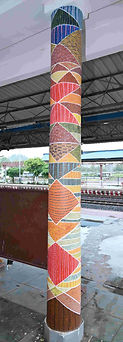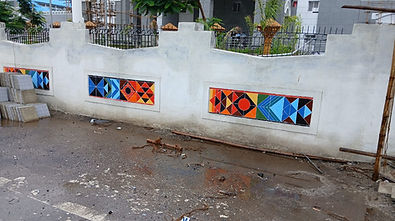


Where trains meet tradition:
Mandla Station Gets a Makeover with Help from Local Artisans

Located near Jabalpur in the heart of Madhya Pradesh, Mandla is surrounded on three sides by the Narmada River and known for its rich heritage and proximity to Kanha National Park, one of India’s largest tiger reserves.
Home to tribal communities like the Gond, Baiga, and Oraon, Mandla is celebrated for its unique art and cultural traditions. In honour of this legacy, the Mandla Railway Station has undergone a vibrant makeover led by local artisans.
Blending traditional tribal art with modern infrastructure, the revamped station now stands as a cultural landmark—welcoming travelers while preserving and promoting the region’s artistic identity.
Queens of Mandla – Murals of Valor & Legacy | Gond
Concourse Area, Mandla Fort Railway Station
Mandla Railway Station now echoes the grandeur of its historic fort, with murals honoring queens Rani Durgavati and Rani Avanti Bai. Depicting scenes of Mandla Fort, ancient temples, and Sahastradhara waterfall, the artworks blend Gond patterns with rich visuals celebrating the queens' bravery and legacy. Created in two phases, composed by contemporary artist Reena Naik and detailed by Gond artisan Sukhiram Maravi, the murals beautifully merge history with tribal art.



Rhythms of the land- Gond
Columns overlooking the platforms, Mandla Fort Railway Station
This striking mural blends bold geometric compositions with the intricate detailing of traditional Gond painting, handcrafted by renowned Gond artist Sukhiram Maravi.
The artwork features repetitive grids, bindus, and vibrant colour blocks, layered with fine, nature-inspired Gond motifs, birds, foliage, and flowing lines. The result is a powerful visual tapestry that reflects both spiritual depth and cultural rootedness, echoing Mandla’s artistic soul.







Of Roots and Rest – Lantana Craft
Front Lawn, Mandla Fort Railway Station
As visitors enter the fort-inspired Mandla Railway Station, they are welcomed by a serene front lawn that reflects the region’s deep connection to nature and craft. Honouring Asia’s largest living Eucalyptus tree, the lawn features eight handcrafted lantana chairs made by local artisans using bark from the surrounding forests. At its heart stands a striking banyan tree installation, also made of lantana, with a traditional seating platform beneath. Developed through a 15-day collaboration with over 15 artisans, the structure symbolizes shelter, community, and Mandla’s creative spirit.

Ceiling of Craft :
Wooden Legacy from Mandla
Concourse Area & Ticket Counter, Mandla Fort Railway Station
Inspired by Mandla’s rich wood carving tradition, the station’s concourse now features hand-carved teakwood ceiling panels with geometric and nature-based motifs, creating a warm, elegant space. The carved ceiling highlights the ticketing area, while teakwood-framed windows along the platform add detail and depth. Each element reflects the legacy of local artisans, turning the station into a tribute to Mandla’s timeless craftsmanship.


Goonj and Jugalbandi – A Dialogue in Art. Gond Paintings
VIP Room, Mandla Fort Railway Station
These artworks are the result of a collaborative effort between Farhat Datta, a Mumbai-based fine artist and environmentalist, and Choti Tekam, a Gond artisan from Patangarh near Amarkantak, Madhya Pradesh.
Goonj captures the vibrance of a lush, bird-filled tree, a classic Gond motif created by Choti. Farhat reimagines this piece as an intimate close-up, highlighting the textures and forms of the leaves, birds, and branches, bringing viewers closer to nature’s rhythms.
Jugalbandi takes the essence of Gond, its symbols, forms, and spirit, and filters it through a contemporary visual lens. It’s a confluence of styles, where tradition meets modern expression.
These works represent a creative bridge between tribal and urban art forms, allowing artisans like Choti to connect with newer audiences while preserving the soul of her tradition.


A tribute in colour- Ceramic Mosaic
Compound Wall Leading to the Railway Station Gate, Mandla Fort Railway Station
On the way to the station gate, the compound wall comes alive with vibrant ceramic tile mosaics featuring bold colours, geometric forms, rhythmic patterns, and layered symbolism. This mural transforms the everyday journey of travelers into an artistic experience, celebrating abstraction and form in a vivid visual language.
Over 10 skilled karigars worked together to handcraft these striking mosaics, creating a grand and contemporary welcome for every visitor entering the station. The artwork adds a strong sense of identity and artistic expression to the cultural landscape of Mandla.


Impact of the project
46+ artisans
Rs. 24.5 lakh revenue for the artisans
Gond, Lantana, Wood carving, Tile mosaic

At EkiBeki, we believe in the power of traditional Indian crafts to tell stories, preserve culture, and transform lives.
EkiBeki is an equal opportunity employer, our team is a mosaic of talents that bring together different backgrounds and expertise, diverse locations and ages. All dedicated to the cause of sustaining Indian traditional artforms and supporting artisans in their livelihoods.

This is an EkiBeki project
Who are we
EkiBeki is a Not for profit focused on identification of dying crafts and undertaking initiatives for their development and sustenance













